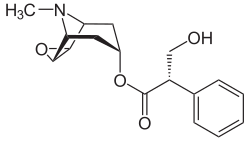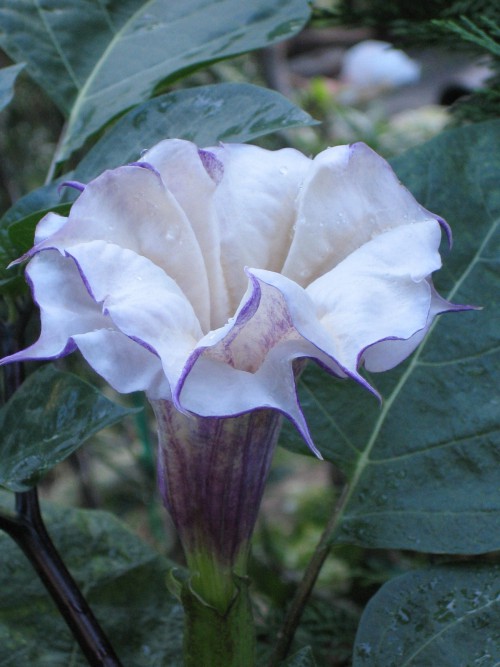Datura metel L. - Solanaceae - metel, Metel-Stechapfel
Annual herb, glabrescent, 0.5-1.5m tall, possible origin West Indies , naturalized and cultivated in subtropical and tropical Asia and Africa; stem often dark violet; leaves ovate or broadly ovate, glabrescent; flower white, yellowish, or pale purple, corolla funnelform, sometimes doubled or tripled, 14-20cm long. „Whole plant, especially seeds, toxic. The flowers are used as an anaesthetic.“ http://www.efloras.org/florataxon.aspx?flora_id=2&taxon_id=200020519
„Datura metel grows in the wild in all the warmer parts of the world, such as India and is cultivated worldwide for its chemical and ornamental properties… The pleasantly-scented 6-8 in. flowers are immensely varied, and can be single or double. Colors range from white to cream, yellow, red, and violet.“ http://en.wikipedia.org/wiki/Datura_metel
„There is a direct link between stage of plant growth and its alkaloid content. In Datura metel var. fastuosa, irrespective of the month of sowing maximum alkaloid in leaves is found before the plant flowers. In later stages there is a gradual fall. Hence the best time to harvest the leaf will be when the plant is 4-5 months old i. e., in pre-flowering stage. Rains considerably lower the alkaloid content. Mature leaves of medium size contain maximum alkaloid. Percentages of hyoscine [= scopolamine] and hyoscyamine both in the leaf and root are not constant at different periods of growth. Hyoscine usually is the principal alkaloid upto preflowering stages, later on hyoscyamine content increases. Analyses of fruits shows that there is a direct relationship between stage of maturity of fruit to its alkaloid content. Very young fruits are found to possess maximum alkaloids. This information may be of immense value for commercial exploitation of this drug plant grown for its alkaloids.“
[The distribution of total alkaloids and major components in the different organs of Datura metel var. Fastuosa at various stages of growth. Gupta, S., Prabhakar, V. S., Madan, C. L., Planta medica, Vol.23(4), 1973, 370-376]
 scopolamine (hyoscine)
scopolamine (hyoscine)
„Datura metel L. var. muricata (Bernh.) Danert was found to be double recessive with respect to the genes concerning the color and form of the corolla by breeding experiments involving four varieties, i.e. var. metel (white, simple corolla), var. rubra (purple, simple), var. fastuosa (purple, double or triple) and var. muricata (white, purple). The results support the proposal by Danert and others that these variants should be considered as varieties or forms of a single species, Datura metel. The analysis of tropane alkaloids in the seeds, flowers, and leaves of these four varieties showed that scopolamine was always dominant over hyoscyamine. The range of the scopolamine content (% of dry weight) of seeds, flowers, and leaves was 0.294 (var. rubra)-0.631 (var. fastuosa), 0.190 (var. metel)-0.698 (var. rubra), and 0.042 (var. rubra)-0.255 (var.metel), respectively. These findings proved that all the varieties, including var. muricata, which exhibited medium scopolamine content among the varieties, can be utilized as sources of scopolamine. “
[Genotypes and alkaloid contents of Datura metel varieties. Hiraoka, N., Tashimo, K., Kinoshita, C., Hiro'oka, M., Biological & pharmaceutical bulletin, Vol.19(8), 1996, 1086-1089]
„… the analgesic activity of D. metel seed extract was found not to be significant (P>0.05) on acetic acid induced model, as well as the radiant heat tail-flick model. The behavioural pattern of sedation and decreased appetite on administration of seed extract could be explained on the basis of the action of some receptors like µ-receptors in the CNS, which when stimulated have the intrinsic potential to reduce the distress or the affective component of pain without having any significant change in the intensity of the actual sensation.“
[Evaluation of the analgesic properties of the Datura metel seeds aqueous extract. Wannang, N. N., Ndukwe, H. C., Nnabuife, C., Journal of Medicinal Plants Research, Vol.3(4), 2009, 192-195]

Datura metel CC BY-SA 3.0, Author: David Dickerson (2005) Wikimedia Commons